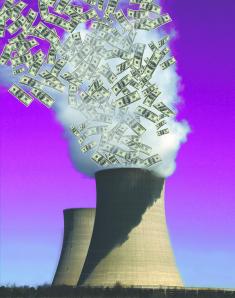Nuclear appeasement is not the solution to climate change
It’s no secret that meaningful climate change has been systematically undermined by powerful special interests, but while some of the usual suspects like Big Oil and Big Coal are stampeding Capitol Hill in an effort to maintain the energy production status quo, Big Nuclear is taking a slightly different approach to thwarting the transition to a clean-energy economy. Not only does the nuclear industry support a climate bill based on a cap-and-trade scheme, it has tapped key nuclear proponents to pack the legislation with gratuitous nuclear handouts and positioned the technology as a legislative deal breaker.
Remember, a new nuclear reactor hasn’t been commissioned for over 30 years; the industry’s manufacturing infrastructure is washed up, its work force is rapidly retiring, construction is prohibitively expensive and costs are constantly climbing, the waste repository the industry has been banking on for the past two decades has been mothballed, and the original financial package intended to shepherd the technology back into existence is no longer adequate. In short, the nuclear industry needs more, much more, again.
Energy Policy Act of 2005 and the so-called nuclear renaissance – A decade ago, the nuclear industry, hand-in-hand with the Bush administration, heralded an imminent nuclear renaissance. However, the comeback was hampered by one important detail: Wall Street – subscribing to the “burned me once” theory – refused to invest. The ticker tape parade was delayed while the Bush administration, congressional nukeheads and the industry crafted and pitched their dream legislation – a would-be vehicle for the renaissance. The result was the 2005 Energy Policy Act. Final tally: $13 billion in nuclear giveaways and a critical provision for unlimited federal loan guarantees. Four years after the enactment of the bill, turns out the dream legislation was not enough.
Underwriting the nuclear relapse: taxpayer-backed loan guarantees – The key provision in EPACT 2005 established a federal loan guarantee program for new nuclear reactors, effectively shifting risk from nuclear developers to American taxpayers. How much risk? The Congressional Budget Office has calculated that the default rate on loans for new nuclear plants is “very high – well above 50 percent.” How much is currently at stake? In 2008, Congress allocated $18.5 billion for the nuclear loan guarantee program after much feet stamping by the industry that was originally seeking $50 billion. They have a point – 5 years ago, when the industry was estimating construction costs for a new reactor at $2 billion, $18.5 billion would have seemed a good start to paving the way for a renaissance. But now, at $10 billion a pop for a new reactor, $18.5 billion is merely chump change for an industry looking to gamble with someone else’s money.
Being a cap-and-trade winner is not enough – Exelon CEO John Rowe, in a recent conference call with financial analysts, provided insight into why the nuclear industry is so jazzed about cap-and-trade. Exelon “expects to see a $1.1 billion-and-growing annual upside to Exelon revenues from implementation of Waxman-Markey.” With 17 nuclear power plants, Exelon runs the largest fleet of reactors in the country. EnergyBizInsider explains the nuclear windfall if a cap-and-trade scheme is adopted to address climate change: assuming an initial carbon price at $7.50 per megawatt-hour in the unregulated market, where Exelon operates, “multiply Exelon’s nuclear generation of 132 million megawatt-hours by the price increase of $7.50 per megawatt-hour and – voila! – you get a revenue increase of $990 million. Call it a billion dollars. As time goes on and the carbon cap gets smaller, the price per ton should rise accordingly.” Interestingly, the current suite of subsidies and windfalls provided by cap-and-trade is not enough to put nuclear back on the market.
Back to the government trough – The nuclear industry has enlisted an array of congressional characters to promote its legislative agenda. The result of which can be best identified in provisions such as the Senate version of the Clean Energy Deployment Administration (which would effectively supplant the loan guarantee program and serve as a slush fund for the nuclear industry), in new nuclear titles being promoted by Kerry, Graham and Lieberman, or in a new nuclear bill intended to replace Waxman-Markey altogether (such as new legislation being peddled by Senators Alexander and Webb). Any of these should be a sign that appeasement is not the right strategy.
The lion’s share – The bottom line is the more the nuclear industry gobbles up federal subsidies and incentives, whether through unlimited access to taxpayer money or by shoehorning its way into being defined as a renewable energy source, the less is available for real clean solutions. Worse yet, as history and current experience suggest, not only is nuclear unable to be weaned off a steady flow of government handouts, but committing taxpayers to guarantee nuclear loans could mean a whole new round of taxpayer-backed bailouts. Moody’s accurately characterizes this gamble as “bet-the-farm.” So, rethinking whether nuclear is a good idea? Think again.
Allison Fisher is Public Citizen’s Energy Organizer
